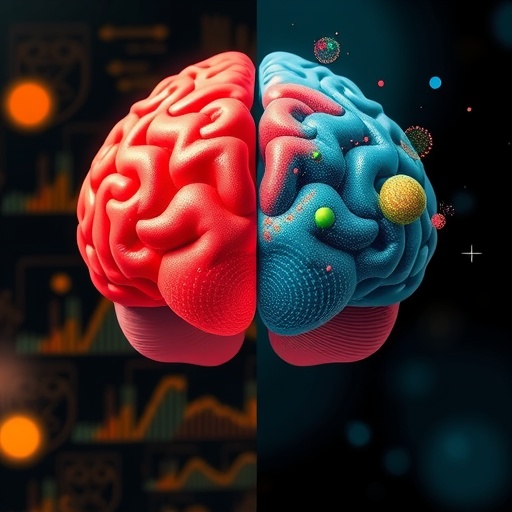In the realm of cognitive neuroscience, the intricate machinery of spatial attention — the mental spotlight that sharpens our perception of the world around us — has long captivated researchers. Yet, an intriguing question lingers: does this same spotlight beam its focus with identical precision and mechanism when it is aimed inward, illuminating mental images conjured from memory? Anthony Clément and Catherine Tallon-Baudry of École normale supérieure have recently challenged the prevailing assumption that spatial attention operates uniformly, whether directed at external stimuli or internal mental representations. Their groundbreaking study, published in the esteemed journal JNeurosci, pioneers an exploration into the neural rhythms and networks governing spatial attention during mental imagery in contrast to direct visual perception.
The researchers devised a sophisticated spatial discrimination paradigm that allowed concurrent recording of brain activity through neuroimaging techniques. This paradigm elegantly disentangles the cognitive processes engaged when individuals orient attention to locations within mental maps as opposed to perceived visuals. Participants were tasked with recalling the geographical map of France from long-term memory, consciously focusing their internal attention on specific hemispheres of this mental map, either east or west. Subsequently, city names appeared, compelling subjects to leverage their mental spatial representations to discern which city was geographically closer to Paris. This imaginative spatial reasoning demanded active engagement with internally generated visual material in a manner fundamentally distinct from traditional visual attention tasks.
A core revelation of Clément and Tallon-Baudry’s study is the revelation that spatial attention does not trivially transplant from perception to imagination. Neurophysiological data indicate that, while orienting attention towards external visual stimuli predominantly activates posterior cortical regions — including occipital and parietal lobes known for processing sensory input — the act of attending to mental images recruits frontal brain areas to a greater extent. This anterior shift in neural engagement suggests a qualitatively different spatial attention mechanism operating during mental imagery, potentially reflecting the involvement of executive control processes necessary for internally generated, abstract representations.
This bifurcation in the neural substrates of spatial attention bears profound implications for how cognitive neuroscience conceptualizes the mind’s eye. The classical view that mental imagery reuses sensory cortical circuitry, essentially mirroring perception, is nuanced by this evidence of distinct spatial formats and attentional orientations. Frontal brain regions, often associated with higher-order functions such as working memory, planning, and decision-making, appear to subserve the internally driven attentional spotlight, implying a more complex interplay between memory retrieval and attentional control than previously recognized.
Moreover, these findings challenge the simplistic analogy of mental imagery as a mere internal replica of visual scenes. Instead, mental images might be constructed and manipulated within neural architectures optimized for abstract, multimodal integration rather than sensory fidelity. The difference in spatial attention mechanisms between mental imagery and perception reflects the brain’s adaptability to contextually diverse cognitive demands — switching from externally oriented sensory processing to internally oriented conceptual navigation.
Methodologically, the study’s reliance on tasks requiring participants to actively recall and navigate mental maps underscores the importance of psychophysiological rigor in studying internal cognitive processes. By pairing behavioral measures of spatial discrimination with real-time brain recordings, Clément and Tallon-Baudry provide a rare, dynamic window into how attention operates not just on what we see, but on what we remember and imagine—a realm often considered elusive to empirical scrutiny.
This research also has encouraging ramifications for the understanding of conditions characterized by disrupted spatial cognition or imagery, such as certain neuropsychological disorders. For example, elucidating the neural divergences between perception and mental imagery could inform novel therapeutic strategies for patients with impairments in spatial memory or attention deficits, offering targeted interventions that tap into frontal executive networks.
The broader cognitive implications extend to foundational debates about consciousness and internal experience. The discovery of dissociable neural substrates for spatial attention across perception and imagination bolsters the argument that consciousness is not a monolithic phenomenon but a composite of distinct, interacting brain functions. It invites future inquiry into how varying attentional mechanisms influence the vividness, clarity, and accuracy of subjective mental imagery, potentially bridging gaps between neuroscience and philosophy of mind.
Additionally, the study emphasizes the dynamic role of attention as an adaptive cognitive tool, capable of flexibly reallocating resources to optimize either perception or imagination, depending on situational demands. This adaptability is likely mediated by the brain’s capacity for neural reconfiguration, whereby distinct networks are recruited to support the unique cognitive architecture of mental image generation versus sensory processing.
In sum, the work by Clément and Tallon-Baudry invites us to reconceptualize spatial attention not as a unitary process, but as a multifaceted neural function tailored to the cognitive context — whether scanning the external world or navigating the mind’s internal landscape. This nuanced view holds promise for advancing our understanding of memory, mental imagery, and consciousness itself, potentially unlocking new horizons for both basic research and applied neuroscience.
The elegance and precision of this investigation remind us that the mind’s eye, while metaphorically akin to a spotlight, employs a repertoire of neural instruments distinct from those that illuminate our visual reality. Such findings propel the neuroscience community toward a richer appreciation of the brain’s capacity for internal thought, challenging us to further unravel the complexity of how we perceive, remember, and imagine space.
As cognitive science advances, studies like this underscore the indispensability of addressing internal cognitive faculties with the same empirical vigor traditionally reserved for perceptual processes. It is only through such integrative approaches that we can aspire to decode the full tapestry of human cognition and the elusive qualities that define our mental lives.
Subject of Research: People
Article Title: Mental Images from Long-Term Memory Differ from Perception: Evidence for Distinct Spatial Formats and Distinct Mechanisms of Spatial Attention Orientation
News Publication Date: 20-Oct-2025
Web References: 10.1523/JNEUROSCI.0691-25.2025
References: Please contact media@sfn.org for full-text PDF.
Keywords: Mental images, Cognition, Long term memory, Geography




